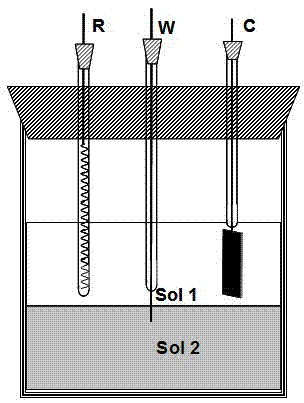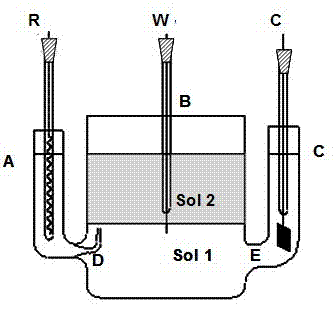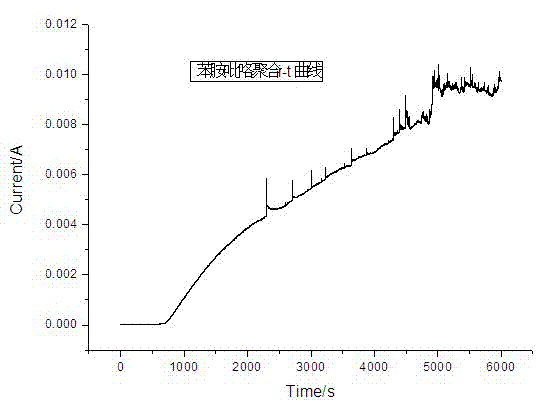Preparation method of conductive polyaniline polypyrrole composite membrane
A polyaniline polypyrrole and composite membrane technology, which is applied to electrolytic components, electrolytic processes, electrolytic organic production, etc., can solve problems such as poor results, and achieve convenient regulation of polymerization speed, good electrical conductivity, and the relationship between morphology and polymerization potential. significant effect
- Summary
- Abstract
- Description
- Claims
- Application Information
AI Technical Summary
Problems solved by technology
Method used
Image
Examples
Embodiment 1
[0032] First take a certain amount of polymerized monomer aniline (AN), pyrrole (PY) and supporting electrolyte perchloric acid (HClO 4 ) were dissolved in organic solvent dichloromethane and water respectively, and were made into 0.01mol / L AN and 0.01mol / L PY dichloromethane solution and 0.2mol / L HClO 4 Aqueous solution; Take the dichloromethane solution and HClO dissolved in AN and PY monomers successively 4 aqueous solution in figure 1 In the single-port polymerization device shown, a clear liquid-liquid interface is formed; then a certain length of platinum wire working electrode (0.5 mm in diameter) is vertically and slowly inserted into the liquid-liquid interface, and the platinum wire is ensured to slightly exceed the liquid-liquid interface and penetrate deep into the liquid-liquid interface. The oil phase is about 0.5mm, the platinum auxiliary electrode and the saturated calomel (SCE) reference electrode are inserted into the upper layer of LiClO 4 In aqueous solut...
Embodiment 2
[0034] First take a certain amount of polymerized monomer aniline (AN) and pyrrole (PY) and supporting electrolyte sulfuric acid (H 2 SO 4 ) were dissolved in organic solvent chloroform and water respectively, and were made into 0.5mol / L AN and 0.5mol / L PY chloroform solution and 2mol / LH 2 SO 4 Aqueous solution; take a certain volume of chloroform solution of AN and PY and H 2 SO 4 aqueous solution in figure 1In the single-port polymerization device shown, a clear liquid-liquid interface is formed; then a certain length of platinum wire working electrode (0.5 mm in diameter) is vertically and slowly inserted into the liquid-liquid interface, and the platinum wire is ensured to slightly exceed the liquid-liquid interface and penetrate deep into the liquid-liquid interface. The oil phase is about 0.5mm, and the platinum auxiliary electrode and saturated calomel (SCE) reference electrode are inserted into the upper H 2 SO 4 In aqueous solution; use constant potential 0.7V (...
Embodiment 3
[0036] Take a certain amount of polymerized monomer aniline (AN) and pyrrole (PY) and the supporting electrolyte lithium perchlorate (LiClO 4 ) were dissolved in organic solvent chloroform and water respectively, and were made into 0.05mol / L AN and 0.5mol / L pyrrole chloroform solution and 0.5mol / L LiClO 4 aqueous solution; sequentially take a certain volume of AN and PY chloroform solution and LiClO 4 aqueous solution in figure 1 In the single-port polymerization device shown, a clear liquid-liquid interface is formed; then a certain length of platinum wire working electrode (0.5 mm in diameter) is vertically and slowly inserted into the liquid-liquid interface, and the platinum wire is ensured to slightly exceed the liquid-liquid interface and penetrate deep into the liquid-liquid interface. The other phase is about 0.5mm, the platinum auxiliary electrode and the saturated calomel (SCE) reference electrode are inserted into the upper layer of LiClO 4 In aqueous solution; us...
PUM
 Login to View More
Login to View More Abstract
Description
Claims
Application Information
 Login to View More
Login to View More - R&D
- Intellectual Property
- Life Sciences
- Materials
- Tech Scout
- Unparalleled Data Quality
- Higher Quality Content
- 60% Fewer Hallucinations
Browse by: Latest US Patents, China's latest patents, Technical Efficacy Thesaurus, Application Domain, Technology Topic, Popular Technical Reports.
© 2025 PatSnap. All rights reserved.Legal|Privacy policy|Modern Slavery Act Transparency Statement|Sitemap|About US| Contact US: help@patsnap.com



